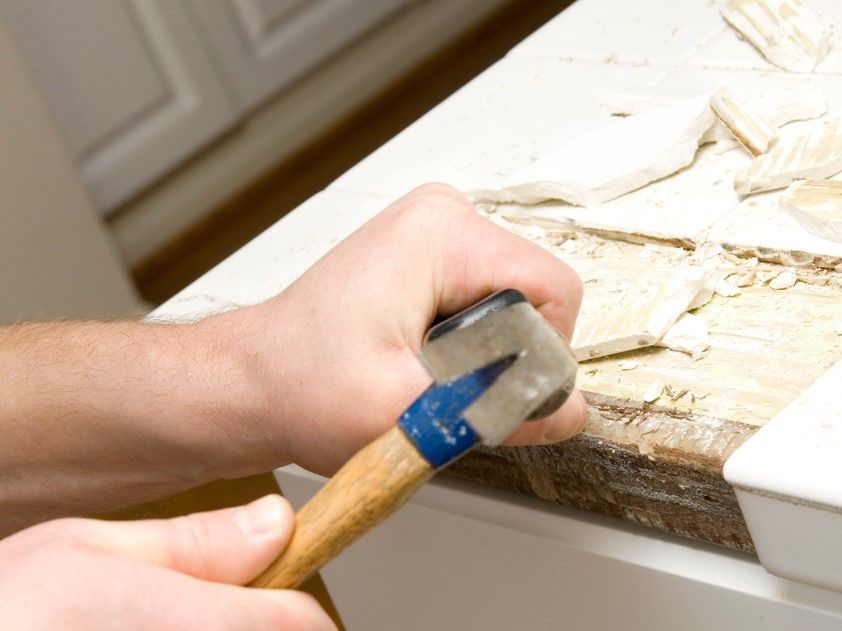TILE REPAIRS DERBY
PROVIDING SERVICES FOR THE REPAIR OR REPLACMENT OF BROKEN TILES ACROSS DERBYSHIRE
GET A QUICK FREE TILING REPLACEMENT QUOTE
SEND 24/7
Bathroom Tiling enquiry
We will get back to you as soon as possible.
Please try again later.
TILING REPAIRS
Broken or cracked tiles can significantly detract from the aesthetic appeal of any room, whether it’s a bathroom, kitchen, or living space. Of more concern is the potential for an accident to occur as a result of not address a broken tile problem, especially if the break is in a floor tile.
As well as installing new tile projects Derbyshire Tiling Specialists also provide tile repair and replacement services too. Often this will involve replacing a tile or section of tiles until one of our professional tilers has assessed the tile damage we can't be sure which option will provide the best long term solution, which may also be influenced why the availability of suitable replacement tiles.
If you have an issue with your existing tiles don't hesitate to get in touch.

Slide title
Write your caption hereButton
FLOOR TILE REPAIR NEAR ME
If you live in Derby or further afield in Derbyshire and are looking for floor tile repair near me we come to you - so we're ideal!
TILE REPLACEMENT DERBY
Tile damage can occur for various reasons, often related to the type of room and the specific conditions the tiles are exposed to. The most frequent causes of tile breakages and cracks include:
1. Impact Damage:
Dropping heavy objects onto tiled surfaces, particularly on floors in kitchens and bathrooms, can lead to chips, cracks, or complete shattering.
2. Substrate Movement:
In areas prone to structural shifts, such as older UK homes, or a new home or extension that has not fully completed settlement lead to movements in the subfloor or walls that can cause tiles to crack or pop out of place.
3. Poor Installation:
Inadequate adhesive coverage, uneven substrate, or improper grouting can result in tiles becoming loose or cracked over time.
4. Temperature Changes:
Kitchens and bathrooms are susceptible to temperature fluctuations, which can cause tiles to expand and contract, leading to cracks.
5. Moisture Intrusion: I
n bathrooms, moisture can seep behind tiles if grout becomes damaged, leading to loosening and cracking.
6. Heavy Foot Traffic:
Hallways, kitchens, and entryways experience frequent use, making them vulnerable to wear and eventual breakage.
Leaving damaged tiles unrepaired can lead to several issues, including:
1. Safety Hazards:
Sharp edges from cracked tiles can cause injuries, especially in areas frequented by children or pets.
2. Water Ingress:
In wet rooms like bathrooms and kitchens, water can penetrate behind cracked tiles, causing dampness, mould growth, and damage to the subfloor.
3. Structural Integrity:
A damaged tile can compromise the stability of the surrounding tiles, leading to a domino effect of further cracks and damage.
4. Reduced Property Value:
Visibly damaged tiles can decrease the aesthetic appeal of a home, potentially impacting its market value.
TILE REPLACEMENT
If you live in Derby or further afield in Derbyshire and are looking to replace your tiles either due to damage or simply !
TILING REPAIR OR REPLACEMENT IN DERBY
The decision to repair or replace a broken tile depends on several factors, including the extent of the damage, tile availability, and the overall condition of the tiled area.
Our professional tiler will first inspect the damage to determine whether the tile can be repaired or needs replacement. Small chips and hairline cracks can often be repaired, whereas larger fractures or dislodged tiles typically require replacement.
For repairs, depending on the tile he may use a combination of epoxy resin, tile filler, and colour-matching sealants. For direct replacements, this will largely depend on sourcing matching tiles, and grout. Many homeowners keep to odd spare tile following a new installation for this very reason however if this is not the case or additional tiles are removed a fingers cross moment with the tile supplier usually follows. Some tile types are timeless and suppliers will stock these for many years. Others are held on a short term a basis based on what is on trend at the time. If replacement is the only option a possible remedial solution would be to find similar sized tiles and use these replacement tile to provide a wall feature by being distinctly different. Depending on the location of the damage in a number of instances the end result is much preferred to the original tile set up.
If our tiler is carrying out a repair the steps taken will include:
- Cleaning the Tile: To remove dust and loose debris.
- Filling Cracks: An epoxy or a specialist tile filler is applied to hairline cracks, carefully smoothed, and left to cure.
- Chipped Edges: For minor chips, a pigmented filler is applied, shaped, and sealed for durability.
- Polishing and Sealing: Once dried, the repaired area is lightly polished to blend seamlessly with surrounding tiles.
If replacement is necessary, our tiler will:
- Remove the Damaged Tile: Using a chisel and hammer, the broken tile or tiles are carefully chipped out without damaging adjacent tiles.
- Clean the Substrate: All old adhesive and debris are removed, ensuring a clean surface for the replacement tiles. This is critical to ensure secure the replacement tile properly.
- Install the New Tile: Fresh adhesive is applied, and the replacement tile is set in place, ensuring alignment and spacing.
- Grouting and Sealing: Once the adhesive sets, the new grout is applied, matched to the existing grout colour.
Whilst our tilers are happy to provide a solution to your tile issues they are keen to ensure any preventative measures are taken to prevent any breakage reoccurrences. They know that different rooms pose unique challenges for tile repair or replacement. In bathrooms water damage is a primary concern, so our tiler will ensures that waterproof grouts and sealants are used during repair or replacement to maintain moisture resistance. In Kitchens heat-resistant adhesives and grout are essential in kitchens, especially near cooking areas. Our professional will assess whether the damage resulted from thermal expansion and choose appropriate materials. For living rooms and hallways these areas often use larger-format tiles or decorative patterns, making it crucial to maintain visual consistency when replacing tiles.
Attempting DIY tile repairs can lead to further damage if not executed correctly. Our professional tiler brings specialised knowledge of adhesives, grouting techniques, and substrate preparation, ensuring a seamless and durable result. Additionally, they can assist with remedial suggestion if you do not have spare replacement tiles when required. Broken or cracked tiles are not just unsightly but can pose safety and maintenance issues if left unattended. Whether opting for repair or replacement, engaging Derbyshire Tiling Specialists ensures a lasting, visually appealing solution, so don't delay your repair any longer, simply call today.
MOST COMMON TILING REPLACEMENT QUESTIONS:
-
Why Choose Derbyshire Tiling Specialist to repair my broken tiles?
We provide tiling services for businesses and residential customers, focussing on a quality finish every time. Our approach to assessing and repairing broken tiles with customers without using jargon means that you know exactly why we have decided on the repair approach we have and what the process will involve.
As part of the Derbyshire Specialist Group we can combine specilist trades to ensure a perfect finish for a additional home improvement projects. We have access to the additional skils of electricians, joiners and plumbers but you will only have once invoice and one gaurantee against all the work done - keep in simple and stress free. Why would you choose anyone else?
-
Can you replace a single tile without dislodging surrounding tiles?
Yes, it is possible to replace a single tile without damaging or dislodging surrounding tiles, but it requires careful execution and the right tools. The first step is to remove the grout around the damaged tile using a grout saw or a rotary tool with a grout removal attachment. This creates enough space to avoid damaging adjacent tiles during the removal process. Once the grout is cleared, the damaged tile can be gently cracked using a hammer and chisel, starting from the center and working outward to the edges. This minimises pressure on the surrounding tiles. After removing the pieces, it's crucial to clean the area thoroughly, removing old adhesive to make a smooth surface for the new tile. During this process we will check the adhesion of the adjacent tiles to ensure that the other tiles are unlikley to need replacing soon.
-
What are the most difficult aspect of repairing or replacing a tile?
Replacing a tile can be a challenging task due to several factors. First, finding an exact match for the damaged tile can be difficult, especially if the tile design is outdated or discontinued. Even minor differences in color or texture can be noticeable and disrupt the harmony of the overall design. Second, removing the damaged tile without affecting the surrounding ones requires precision and care; improper removal techniques can lead to additional damage or breakage. Additionally, once the tile is removed, preparing the surface for the new tile requires meticulous cleaning and leveling, ensuring a seamless transition. Each step involves careful attention to detail to ensure that the repair blends seamlessly with the existing tiles.
Business Hours
- Mon - Sat
- -
- Sunday
- Closed
All Rights Reserved | Derbyshire Tiling Specialists - part of Derbyshire Specialists Group
Derbyshire Specialists Group Ltd is an Introducer Appointed Representative of Ideal Sales Solutions Ltd, t/a Ideal4Finance. Ideal Sales Solutions Ltd is a credit broker and not a lender (FRN 703401). Finance available subject to status. The rate offered is always provisional and will depend upon your personal circumstances, the loan amount and the term.
